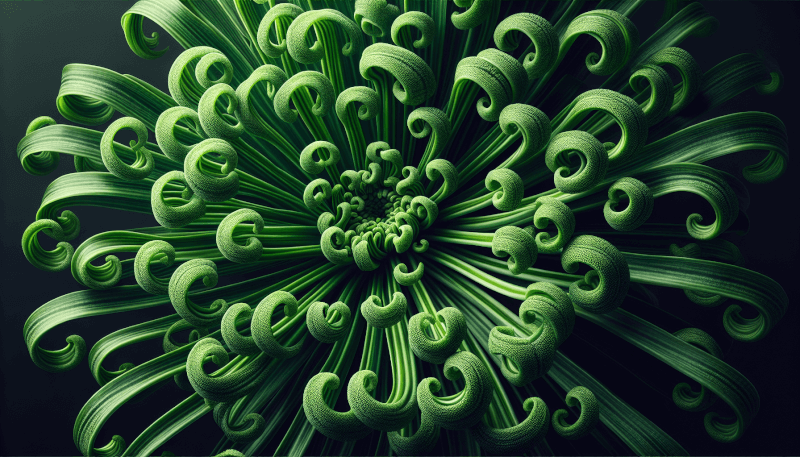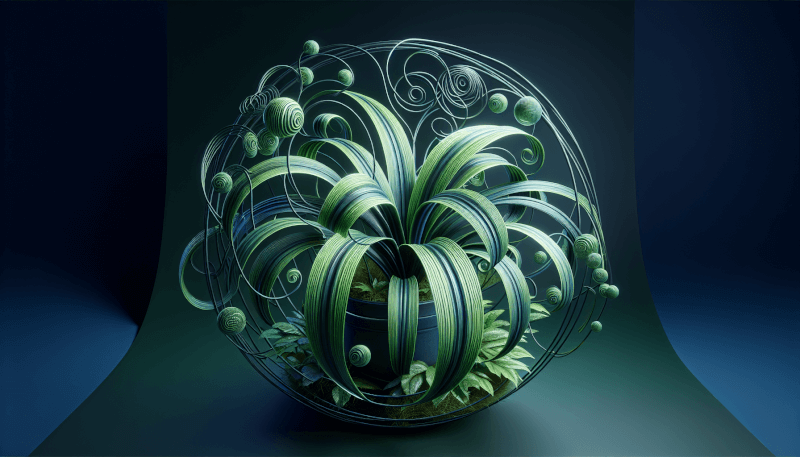If you’re looking for a fascinating plant to add to your indoor garden, look no further than the Curly Spider Plant. Known for its unique curly leaves that cascade down, this plant is not just aesthetically pleasing but also incredibly easy to care for. From providing the right amount of sunlight to watering it just enough, this article will guide you through the essential steps to ensure your Curly Spider Plant thrives in your home. So, get ready to witness the beauty of nature unfold with our simple and friendly care tips for your curly spider plant.

Light Requirements
Indirect sunlight
Curly spider plants thrive in bright, indirect sunlight. They prefer a spot near a window where they can receive ample light, but avoid placing them in direct sunlight as it can scorch their leaves. Indirect sunlight provides the right amount of light for their growth and ensures that they stay healthy and vibrant.
Avoid direct sunlight
While some plants enjoy basking in direct sunlight, the curly spider plant is not one of them. Direct sunlight can cause the leaves to burn and turn brown. It’s best to provide them with bright, indirect sunlight to optimize their growth and keep them looking their best.
Low light tolerance
Despite their preference for bright, indirect sunlight, curly spider plants can also tolerate lower light conditions. They are known to adapt and thrive in areas of lower light, making them a perfect addition to areas in your home that do not receive as much natural light. However, it’s important to note that they will grow slower and might not produce as many offshoots under lower light conditions.
Watering
Regular watering
Keeping your curly spider plant adequately watered is essential for its health and growth. It is recommended to water them regularly, ensuring that the soil is consistently moist but not waterlogged. Check the top inch of soil and water once it feels slightly dry to the touch.
Allow soil to dry between waterings
While regular watering is important, it’s equally crucial to allow the soil to dry out between waterings. Overwatering can lead to root rot and other issues. Insert your finger into the soil to determine its moisture level and only water if it feels dry. By allowing the soil to dry out, you mimic the plant’s natural conditions and prevent waterlogging.
Avoid overwatering
Overwatering is a common mistake when caring for curly spider plants. It’s important to resist the temptation to water them excessively, as it can lead to root rot and the decline of the plant’s health. Always ensure that the top layer of soil has dried out before watering again and adjust your watering frequency according to your plant’s specific needs.
Soil
Well-draining soil
Curly spider plants prefer a well-draining soil that allows excess water to flow through and prevents the roots from becoming waterlogged. Choose a high-quality potting mix that is specifically formulated for indoor plants, ensuring that it provides the necessary aeration and drainage for the plant’s roots.
Potting mix with peat moss
Peat moss is an excellent addition to the potting mix for curly spider plants. It helps retain moisture without risking waterlogging the roots. The peat moss aids in providing a balanced moisture level for the plant while still allowing proper drainage.
Add perlite for better drainage
To further enhance the drainage of the potting mix, adding perlite can be beneficial. Perlite is a lightweight volcanic glass that improves aeration and drainage in the soil. It helps keep the roots healthy and prevents the soil from compacting over time.
Temperature
Average room temperature
Curly spider plants thrive in average room temperatures, usually ranging from 65°F to 85°F (18°C to 29°C). It’s important to keep the plant away from extreme temperature fluctuations to ensure its well-being. Maintain a comfortable room temperature, and your curly spider plant will thank you with lush, green foliage.
Avoid extreme temperatures
As with many houseplants, it’s crucial to avoid subjecting your curly spider plant to extreme temperatures. Protect it from both hot and cold drafts, as they can stress the plant and impact its growth. Avoid placing the plant near air vents or windows during cold winters or hot summers to prevent temperature-related issues.
Protect from cold drafts
Curly spider plants are sensitive to cold drafts, which can cause their leaves to wilt or even die. To protect your plant, avoid placing it in areas where cold air from open windows or air conditioning units directly hits it. Be mindful of the drafts during the colder months and ensure that the plant is kept in a warm and stable environment.

Humidity
Thrives in average indoor humidity
Curly spider plants are well-suited to average indoor humidity levels, making them a versatile choice for various home environments. They can adapt to different humidity conditions, but it’s essential to maintain a moderate humidity level to prevent their leaves from drying out or becoming too moist.
Mist leaves occasionally
To provide your curly spider plant with a boost of humidity, misting the leaves occasionally can be beneficial. The tiny droplets of water mimic the natural humidity that the plant would experience in its native habitat. However, avoid excessive misting, as it can encourage fungal growth and other moisture-related issues.
Avoid excessive dryness
While curly spider plants can tolerate average indoor humidity, it’s important to avoid excessive dryness. Dry air can lead to brown tips on the leaves and make the plant more susceptible to pests and diseases. If your home has particularly dry air, consider using a humidifier or placing a tray of water near the plant to increase humidity levels.
Fertilizing
Monthly during growing season
To promote healthy growth and maintain the curly spider plant’s vitality, it’s recommended to fertilize it monthly during the growing season. This typically occurs from spring to early autumn when the plant is actively growing. Fertilizing during this period ensures that the plant receives the necessary nutrients to thrive.
Use balanced houseplant fertilizer
When selecting a fertilizer for your curly spider plant, opt for a balanced houseplant fertilizer. This type of fertilizer contains equal proportions of nitrogen, phosphorus, and potassium, which provide a balanced nutrient supply for the plant’s overall health and development. Follow the package instructions for proper application and dosage.
Follow package instructions
Each fertilizer brand may have specific instructions for application and dosage. It’s important to carefully read and follow the package instructions when fertilizing your curly spider plant. Over-fertilization can lead to burn the roots and damage the plant, so it’s crucial to use the correct amount and frequency as recommended by the fertilizer manufacturer.
Pruning
Remove yellow or dead leaves
Regular pruning helps maintain the health and appearance of your curly spider plant. Remove any yellow or dead leaves promptly to prevent the spread of disease and to encourage the growth of new, healthy foliage. Use clean and sharp pruning shears to avoid damaging the plant while cutting.
Trim long, trailing stems
Curly spider plants are known for their long, trailing stems, which can sometimes become unmanageable. To keep the plant looking tidy, trim the long stems occasionally. You can prune them back to encourage fuller growth or simply to maintain the desired shape and size of your plant.
Encourage bushier growth
If you prefer a bushier appearance for your curly spider plant, pruning can help achieve that. Trim the longer stems back to promote branching and the growth of multiple offshoots. This creates a fuller and more visually appealing plant. Remember to always use clean and sterilized pruning tools to prevent the spread of diseases.
Propagation
Divide plant at roots
Curly spider plants are incredibly easy to propagate through division. Over time, they produce offshoots or baby spider plants that can be separated from the parent plant and grown independently. Carefully remove the baby spider plants from the main plant, ensuring that each section retains some roots.
Plant divided sections in new pots
Once you have successfully divided the curly spider plant into separate sections, plant each divided section in its own pot. Ensure the new pots have drainage holes and a well-draining soil mix. Gently cover the roots with the soil, making sure they are not buried too deeply or exposed.
Use a well-draining soil mix
Choosing the right soil mix for the newly propagated curly spider plant sections is crucial. Use a well-draining soil mix that promotes root growth and prevents waterlogging. The mixture should include peat moss and perlite for optimal drainage. This ensures that the newly propagated plants establish themselves successfully.
Pests and Diseases
Watch for spider mites and aphids
Curly spider plants are relatively resistant to pests, but it’s essential to keep an eye out for common houseplant pests like spider mites and aphids. These tiny insects can infest the leaves and feed on the plant’s sap, leading to weakened growth and visible damage. Regular inspection helps catch infestations early and prevents them from spreading.
Wipe leaves to remove pests
If you notice pests on your curly spider plant, you can gently wipe the leaves with a damp cloth or sponge to remove them. This physical removal can be effective, especially for small infestations. Pay close attention to the undersides of the leaves, as pests often hide there.
Treat with appropriate insecticide if needed
For more severe pest infestations that cannot be managed through manual removal, treatment with an appropriate insecticide may be necessary. Choose an insecticide specifically formulated for indoor plants, and follow the instructions carefully. Be mindful of the plant’s well-being and ensure the product won’t harm the plant or its surrounding environment.
Common Problems
Brown tips from dryness
If the tips of your curly spider plant’s leaves turn brown, it is usually an indication of dryness. This could be a result of underwatering or insufficient humidity. Adjust your watering routine to ensure the plant receives adequate moisture, and consider increasing humidity levels in its environment to prevent further browning.
Yellowing from overwatering
Yellowing leaves can be a sign of overwatering. If the soil remains consistently wet and waterlogged, it can lead to root rot, causing the foliage to turn yellow. Adjust your watering schedule and allow the top inch of soil to dry before watering again. Ensure proper drainage in the pot and consider repotting if necessary.
Leaf curling from temperature stress
If you notice the leaves of your curly spider plant curling, it might be a sign of temperature stress. Extreme temperatures, especially cold drafts, can cause the leaves to curl and become damaged. Ensure the plant is positioned away from drafts and in a location with stable, moderate temperatures. Providing a warm and consistent environment will prevent further leaf curling.
In conclusion, taking care of your curly spider plant involves providing the right amount of light, watering it correctly, using well-draining soil, maintaining a moderate temperature and humidity, fertilizing properly, pruning when necessary, propagating through division, keeping an eye out for pests and diseases, and addressing common problems like brown tips, yellowing leaves, and leaf curling. By following these guidelines and providing a suitable environment, your curly spider plant will thrive and bring beauty to your indoor space. Enjoy watching it grow and flourish!

